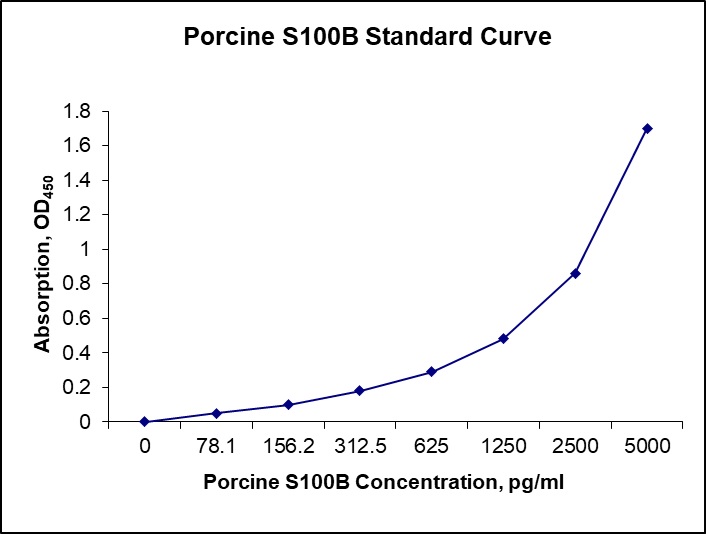Nori Porcine S100B ELISA Kit
$461.00 – $832.00
DataSheet CoA SDS
This ELISA kit is for quantification of S100B in pig. This is a quick ELISA assay that reduces time to 50% compared to the conventional method, and the entire assay only takes 3 hours. This assay employs the quantitative sandwich enzyme immunoassay technique and uses biotin-streptavidin chemistry to improve the performance of the assays. An antibody specific for S100B has been pre-coated onto a microplate. Standards and samples are pipetted into the wells and any S100B present is bound by the immobilized antibody. After washing away any unbound substances, a detection antibody specific for S100B is added to the wells. Following wash to remove any unbound antibody reagent, a detection reagent is added. After intensive wash a substrate solution is added to the wells and color develops in proportion to the amount of S100B bound in the initial step. The color development is stopped, and the intensity of the color is measured.
Alternative names for S100B: S100 calcium-binding protein B, S100-B,
This product is for Laboratory Research Use Only not for diagnostic and therapeutic purposes or any other purposes.
- Description
- How Elisa Works
- Product Citation (0)
- Reviews (0)
Description
Nori Porcine S100B ELISA Kit Summary
Alternative names for S100B: S100 calcium-binding protein B, S100-B,
Alternative name for porcine: Pig
| Assay Type | Solid Phase Sandwich ELISA |
| Format | 96-well Microplate or 96-Well Strip Microplate |
| Method of Detection | Colorimetric |
| Number of Targets Detected | 1 |
| Target Antigen Accession Number | na |
| Assay Length | 3 hours |
| Quantitative/Semiquantitative | Quantitative |
| Sample Type | Plasma, Serum, Cell Culture, Urine, Cell/Tissue Lysates, Synovial Fluid, BAL, |
| Recommended Sample Dilution (Plasma/Serum) | No dilution for sample <ULOQ; sufficient dilution for samples >ULOQ |
| Sensitivity | 15 pg/mL |
| Detection Range | 78.1-5000 pg/mL |
| Specificity | Natural and recombinant porcine S100B |
| Cross-Reactivity | < 0.5% cross-reactivity observed with available related molecules, < 50% cross-species reactivity observed with species tested. |
| Interference | No significant interference observed with available related molecules |
| Storage/Stability | 4 ºC for up to 6 months |
| Usage | For Laboratory Research Use Only. Not for diagnostic or therapeutic use. |
| Additional Notes | The kit allows for use in multiple experiments. |
Standard Curve
Kit Components
1. Pre-coated 96-well Microplate
2. Biotinylated Detection Antibody
3. Streptavidin-HRP Conjugate
4. Lyophilized Standards
5. TMB One-Step Substrate
6. Stop Solution
7. 20 x PBS
8. Assay Buffer
Other Materials Required but not Provided:
1. Microplate Reader capable of measuring absorption at 450 nm
2. Log-log graph paper or computer and software for ELISA data analysis
3. Precision pipettes (1-1000 µl)
4. Multi-channel pipettes (300 µl)
5. Distilled or deionized water
Protocol Outline
1. Prepare all reagents, samples and standards as instructed in the datasheet.
2. Add 100 µl of Standard or samples to each well and incubate 1 h at RT.
3. Add 100 µl of Working Detection Antibody to each well and incubate 1 h at RT.
4. Add 100 µl of Working Streptavidin-HRP to each well and incubate 20 min at RT.
5. Add 100 µl of Substrate to each well and incubate 5-30 min at RT.
6. Add 50 µl of Stop Solution to each well and read at 450 nm immediately.
Background:
S100 calcium binding protein B (S100B) is a protein of the S-100 protein family. S100B is glial-specific and is expressed primarily by astrocytes, but not all astrocytes express S100B. It has been shown that S100B is only expressed by a subtype of mature astrocytes that ensheath blood vessels and by NG2-expressing cells.[1] This protein may function in neurite extension, proliferation of melanoma cells, stimulation of Ca2+ fluxes, inhibition of PKC mediated phosphorylation, astrocytosis and axonal proliferation, and inhibition of microtubule assembly. In the developing CNS it acts as a neurotrophic factor and neuronal survival protein. In the adult organism it is usually elevated due to nervous system damage, which makes it a potential clinical marker. Altered expression of S100B has been implicated in several neurological, neoplastic, and other types of diseases, including Alzheimer’s disease, Down’s syndrome, epilepsy, amyotrophic lateral sclerosis, melanoma, and type I diabetes. It has been suggested that the regulation of S100B by melittin has potential for the treatment of epilepsy. Serum levels of S100B increase in patients during the acute phase of brain damage. S100B levels have been reported to rise prior to any detectable changes in intracerebral pressure, neuroimaging, and neurological examination findings. Thus, the major advantage of using S100B is that elevations in serum or CSF levels provide a sensitive measure for determining CNS injury before gross changes develop, enabling timely delivery of crucial medical intervention before irreversible damage occurs. S100B serum levels are elevated before seizures suggesting that BBB leakage may be an early event in seizure development. [2] An extremely important application of serum S100B testing is in the selection of patients with minor head injury who do not need further neuroradiological evaluation, as studies comparing CT scans and S100B levels have demonstrated S100B values below 0.12 ng/mL are associated with low risk of obvious neuroradiological changes.[3] In addition, S100B, which is also present in porcine melanocytes, is a reliable marker for melanoma malignancy both in bioptic tissue and in serum.[4][5]
References
- Wang DD, Bordey A (2008). Neurobiol.86 (4): 342–67.
- Marchi N, et al. (2007). Epilepsia 48 (4): 732–42.
- Zongo, D., et al. (2012). Annals of Emergency Medicine 59(1): 209–218.
- Michetti F, et al. (2012). J. Neurochem. 120 (5): 644–59.
- Cocchia D, et al. (1981). Nature 294 (5836): 85–7.
Be the first to review “Nori Porcine S100B ELISA Kit”
You must be logged in to post a review.




























Reviews
There are no reviews yet.